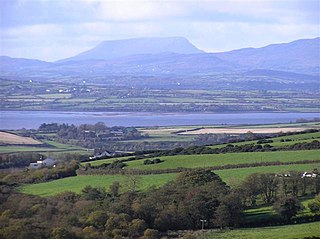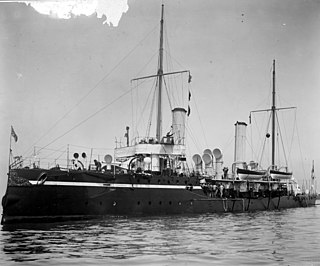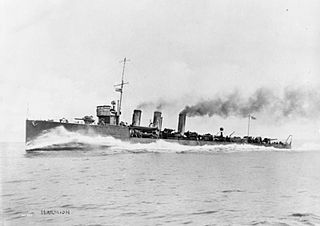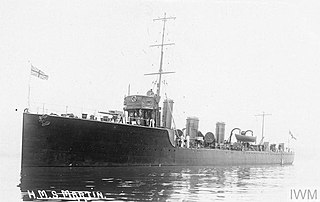
Lough Swilly in Ireland is a glacial fjord or sea inlet lying between the western side of the Inishowen Peninsula and the Fanad Peninsula, in County Donegal. Along with Carlingford Lough and Killary Harbour it is one of three glacial fjords in Ireland.
Numerous Royal Navy vessels have been named HMS Dolphin after the dolphin.

The Londonderry and Lough Swilly Railway Company was an Irish public transport and freight company that operated in parts of County Londonderry and County Donegal between 1853 and 2014. Incorporated in June 1853, it once operated 99 miles of railways. It began the transition to bus and road freight services in 1929. It closed its last railway line in July 1953 but continued to operate bus services under the name Lough Swilly Bus Company until April 2014, becoming the oldest railway company established in the Victorian era to continue trading as a commercial concern into the 21st century. Following a High Court petition by HM Revenue and Customs, the company went into liquidation and operated its final bus services on 19 April 2014.

Londonderry Port, now operating as Foyle Port, is a port located on Lough Foyle in Northern Ireland. It is the United Kingdom’s most westerly port and an important northerly port on the island of Ireland. The current port is at Lisahally, County Londonderry, though historically the port was upriver in the city of Derry itself. It is operated by the Londonderry Port and Harbour Commissioners, whose former offices, just north of the city's walls, are now a museum.
HMS K6 was a British K class submarine built by HM Dockyard, Devonport. She was laid down on 8 November 1915 and commissioned in May 1917. K6 was the first of the K class to have its bows raised by converting it into a bulbous swan shape.

HMS Ultor (P53) was a Royal Navy U-class submarine built by Vickers-Armstrong at Barrow-in-Furness, launched in 1942, and part of the third group of the class. So far she has been the only ship of the Royal Navy to bear the name Ultor.

HMS H28 was a British H-class submarine built by Vickers Limited, Barrow-in-Furness, as part of the Batch 3 H-class submarines. She was laid down on 18 March 1917 and was commissioned on 29 June 1918. H28 was the only British submarine to see active service in both World Wars, and was finally scrapped in 1944.

HMS Conflict was the lead ship of the Conflict-class destroyers built by J. Samuel White, at East Cowes, Isle of Wight for the Royal Navy. She was launched on 13 December 1894, and entered service in 1899. After an initial spell in the Mediterranean Fleet, Conflict returned to British waters, where she served the rest of her career. Conflict was part of the Portsmouth Local Defence Flotilla during the First World War, which she survived. Conflict was sold for scrap on 20 May 1920.

HMS Surly was a Rocket-class destroyer of the Royal Navy. She was launched at Clydebank in 1894, served in home waters and was sold in 1920.

HMS Racer was a Royal Navy Mariner-class composite screw gunvessel of 8 guns.

HMS Recruit was a Clydebank three-funnel, 30-knot destroyer ordered by the Royal Navy under the 1895–1896 Naval Estimates. She was the fifth ship to carry this name since it was introduced in 1806 for an 18-gun brig-sloop, sold in 1822.

HMS Circe was a Alarm-class torpedo gunboat of the British Royal Navy. She was built by Sheerness Dockyard from 1890–1893. She was converted to a minesweeper in 1908–1909 and continued these duties during the First World War. Circe was sold for scrap in 1920.
HMS TB 5 was a Cricket-class coastal destroyer or torpedo-boat of the British Royal Navy. TB 5 was built by the shipbuilder J S White from 1905 to 1907. She was used for local patrol duties in the First World War and survived the war. She was sold for scrap in 1920.

HMS Tirade was a Modified Admiralty R-class destroyer which served with the Royal Navy during World War I. The Modified R class added attributes of the Yarrow Later M class to improve the capability of the ships to operate in bad weather. Launched in April 1917 by Scotts Shipbuilding and Engineering Company, the vessel served with the Grand Fleet. The vessel was involved in escorting convoys in the Irish Sea and North Sea. During one of these duties, in September 1917, Tirade sank the minelaying submarine UC-55. During the following month, the destroyer accidentally struck and sank the M-class destroyer Marmion. After the war the destroyer was placed in reserve and then, in November 1921, was sold to be broken up.

HMS Raider was the second of a class of sixty two R-class destroyers operated by the Royal Navy. Launched in 1916, the vessel served with the Grand Fleet during World War I. The destroyer was built as part of the preceding M-class but was equipped with geared turbines which improved efficiency and increased range. The ship was involved in anti-submarine patrols, but did not sink any German submarines. After the war, the destroyer initially moved to Harwich and was briefly stationed in Ireland after the Irish Civil War. In 1923, the Navy decided to retire the older destroyers in the fleet and, although initially spared, Raider was decommissioned and sold to be broken up in 1927.

HMS Sarpedon was an R-class destroyer which served with the Royal Navy. The R class were a development of the preceding M-class, but differed in having geared turbines and other design changes. Launched in June 1916, the vessel escorted convoys that sailed between Scotland and Scandinavia in the First World War. After the war, the ship was allocated to local defence at Nore. However, in 1923, the Navy decided to retire many of the older vessels and Sarpedon was retired and was sold to be broken up on 23 June 1926.

HMS Hearty was a fishery protection vessel and survey ship of the British Royal Navy. Built by the Scottish shipbuilder W. B. Thompson as the tug Indra, the ship was launched in 1885 and purchased by the Royal Navy. Hearty was sold in 1920 for use as a salvage vessel. She was renamed Dalhousie in 1921, and was sold for scrap in 1930, being scrapped in 1935.

HMS Magic was an Admiralty M-class destroyer which served with the Royal Navy during the First World War. The M class were an improvement on the previous L class, capable of higher speed. Originally laid down as HMS Marigold by J. Samuel White at East Cowes on the Isle of Wight, the vessel was renamed before being launched in 1915. The ship served during the War as part of the Grand Fleet, mainly on anti-submarine and convoy escort duties from the port of Queenstown. In 1917, the destroyer took part in the Battle of Jutland and was one of a small number of British vessels that attacked the German fleet with torpedoes, although both torpedoes missed. In 1918, the ship struck a mine of the coast of Ireland and, although the damage was repaired, 25 people died. After the War, the destroyer was placed in reserve and decommissioned, being sold to be broken up in 1921.

HMS Narwhal was a Admiralty M-class destroyer which served with the Royal Navy during the First World War. The M class were an improvement on the preceding L class, capable of higher speed. Launched on 30 December 1915, the vessel fought in the Battle of Jutland between 31 May and 1 June 1916 and subsequently served in anti-submarine and escort duties based at Cobh in Ireland. During February 1917, the destroyer rescued the crew of the Q-ship Farnborough, which had sunk and been sunk by the German submarine SM U-83, and rescued the armed merchantman Cameronia from SM U-50, The destroyer was transferred to Devonport during 1918 and, after the end of the war, was broken up there in 1920 after suffering a fatal collision the year before.

HMS Martin was one of 20 Acorn-class destroyers built for the Royal Navy. The destroyer served in the First World War. The Acorn class was smaller than the preceding Beagle class but oil-fired and better armed. Launched in 1910, Martin joined the Second Destroyer Flotilla. After the British Empire declared war on Germany at the beginning of the First World War, the ship joined the Grand Fleet and was based at Devonport. While undertaking anti-submarine patrols and escorting merchant ships around the British Isles, the destroyer damaged the submarine U-60 and potentially sank U-69. Martin ended the war in Brindisi with the Mediterranean Fleet. After the Armistice, the destroyer remained in the Mediterranean until being sold to be broken up in 1920.















